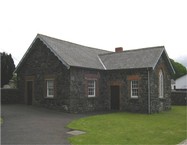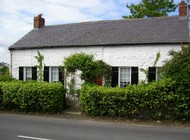Life In The 1800’s
St Mary’s a ‘WELL’ Church growing through prayer and service
In the early 1800’s conditions within the Parish were relatively good, even though many were poor and housing very basic. The houses were mainly stone, unplastered inside and out and thatched, although in the village of Macosquin the houses were slated. Work was mainly of an agricultural nature, small tenant farmers providing most of the work. Somerset House employed most of the female parishioners as domestic servants and a substantial number of men worked in the gardens and stables.
Other occupations were of a home based nature, weavers, tailors, shirt makers and shoe makers. The weavers and shirt makers worked for agents who collected the completed work for businesses and warehouses. The setting up of the Gribbons factory in Killowen brought about the end of the home based weaving and shirt factories in Coleraine reduced the demand for home made shirts. In many rural areas the demand for tailor made suits, home made shirts and shoes continued right into the middle of the present century.
Corn and flax were extensively grown in the Macosquin area and provided much needed employment in harvesting and milling. Within the Parish Flax Mills were located and known as Boylans in Balteagh, “Sam Marshalls” in Ringrash, “WillieMooneys”in Macosquin, “William Olivers” later Wallaces in Englishtown and “William McCollums” in Drumcroon. All these employed men as “scutchers” and women as “stickers” and “roller feeders” between the months of October and March. Willie Mooney also operated a cornmill in the village (on the site of Churchview Park) grinding corn to produce oat meal which was very much the diet of the local people. These mills were all driven by water wheels so they were all situated beside or close to the river. Another business in the Parish at this time was the Bleach Green where linen cloths were whitened to enable them to be made into garments, table cloths and bed cloths etc. Much later the premises were used for growing mushrooms and continued to give employment to local people.
Among the late Canon Armstrong’s memorabilia is a letter which appeared in a local newspaper.
It is signed J.R.C. Portrush, and reads:
 “I am an old scholar of Macosquin Day School and Sunday School. I was baptised and confirmed in the adjoining Episcopal Church. I know they have got a new school since I was there but I would not know the old Church. In my young days there was a wall between the road and the Church, and people went in through a gate. There was a small gate from the Church to the school, one end rested on the Church wall. The window looked into the Church door.
“I am an old scholar of Macosquin Day School and Sunday School. I was baptised and confirmed in the adjoining Episcopal Church. I know they have got a new school since I was there but I would not know the old Church. In my young days there was a wall between the road and the Church, and people went in through a gate. There was a small gate from the Church to the school, one end rested on the Church wall. The window looked into the Church door.
There was no clock in those days. As a child I never knew Macosquin was such an important place . If I could have told anyone what I thought of Macosquin, I would have said it was one of the most dreariest and miserable places on earth, as a girl I would have said the same. The only place in Macosquin that I ever thought was nice was Mrs Hanson’s Ivy Cottage and a window with sugar sticks.
 I loved the little Church, the choir sat up in the gallery. The Sinclair’s of Dunderg sat in one corner downstairs, the Smith’s of Farranlester in the other, the Finlay’s in front of them. Miss Richardson and Mrs Torrens sat down the isle near to the pulpit.
I loved the little Church, the choir sat up in the gallery. The Sinclair’s of Dunderg sat in one corner downstairs, the Smith’s of Farranlester in the other, the Finlay’s in front of them. Miss Richardson and Mrs Torrens sat down the isle near to the pulpit.
I used to hear about the Bleach Green and about scares that the night watchman got sometimes.
I can say that the happiest days of my life were spent in and around Macosquin. I can still recall the thrill of the Sunday School picnic to Castlerock by wagonette, and especially the bag of buns we were given before leaving. We got these in Richardson’s Memorial School on the hill. There was also a spring in the field near the Church, no water ever tasted quite as good”.
